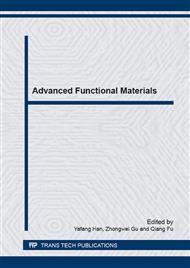[1]
M. Kanda, K. Yuse, D. Guyomar, Y. Nishi, Controllable Electrostriction of Polyurethane Film, Trans Tech Publ, 2014, 2429-32.
DOI: 10.4028/www.scientific.net/msf.783-786.2429
Google Scholar
[2]
A.C.V. Da Nóbrega, A.E. Martinelli, D.M.D.A. Melo, M.A. de Freitas Melo, J.C. de Oliveira Freitas, F.S. de Oliveira, Effect of Mud Acid on Portland-Aqueous Polyurethane Composites to Oil Well Cementing, Trans Tech Publ, 2013, 307-12.
DOI: 10.4028/www.scientific.net/msf.730-732.307
Google Scholar
[3]
Z. Zhang, H. Song, X. Men, Z. Luo, Effect of carbon fibers surface treatment on tribological performance of polyurethane (PU) composite coating, Wear, 264(2008) 599-605.
DOI: 10.1016/j.wear.2007.05.003
Google Scholar
[4]
H. Yuan, P. Hu, Study of a compatibilized ultra-high-molecular-weight polyethylene and polyurethane blend, J Appl Polym Sci, 81(2001) 3290-3295.
DOI: 10.1002/app.1785
Google Scholar
[5]
S. Cao, H. Liu, S. Ge, G. Wu, Mechanical and tribological behaviors of UHMWPE composites filled with basalt fibers, J Reinf Plast Comp, 30(2011) 347-55.
DOI: 10.1177/0731684410394698
Google Scholar
[6]
S. Wannasri, S.V. Panin, L.R. Ivanova, L.A. Kornienko, S. Piriyayon, Increasing wear resistance of UHMWPE by mechanical activation and chemical modification combined with addition of nanofibers, Procedia Engineering, 1(2009) 67-70.
DOI: 10.1016/j.proeng.2009.06.018
Google Scholar
[7]
F. Saulnier, M. Dubois, K. Charlet, L. Frezet, A. Beakou, Direct fluorination applied to wood flour used as a reinforcement for polymers, Carbohyd Polym, 94(2013) 642-646.
DOI: 10.1016/j.carbpol.2013.01.060
Google Scholar
[8]
A.P. Kharitonov, G.V. Simbirtseva, V.M. Bouznik, M.G. Chepezubov, M. Dubois, K. Guerin, A. Hamwi, H. Kharbache, F. Masin, Modification of Ultra-High-Molecular Weight Polyethylene by Various Fluorinating Routes, J Polym Sci Pol Chem, 49(2011).
DOI: 10.1002/pola.24793
Google Scholar
[9]
S. Wang, S. Ge, The mechanical property and tribological behavior of UHMWPE: Effect of molding pressure, Wear, 263(2007) 949-956.
DOI: 10.1016/j.wear.2006.12.070
Google Scholar
[10]
A.P. Kharitonov, L.N. Kharitonova, Surface modification of polymers by direct fluorination: a convenient approach to improve commercial properties of polymeric articles, Pure Appl Chem, 81(2009) 451-71.
DOI: 10.1351/pac-con-08-06-02
Google Scholar
[11]
A. Tressaud, E. Durand, C. Labrugère, A.P. Kharitonov, L.N. Kharitonova, Modification of surface properties of carbon-based and polymeric materials through fluorination routes: From fundamental research to industrial applications, J Fluorine Chem, 128(2007).
DOI: 10.1016/j.jfluchem.2006.12.015
Google Scholar
[12]
A.M. Ferraria, J.D. Lopes Da Silva, A.M. Botelho Do Rego, Optimization of HDPE direct fluorination conditions by XPS studies, J Fluorine Chem, 125(2004) 1087-1094.
DOI: 10.1016/j.jfluchem.2004.01.014
Google Scholar
[13]
A. Majjane, A. Chahine, M. Et-tabirou, B. Echchahed, T. Do, P.M. Breen, X-ray photoelectron spectroscopy (XPS) and FTIR studies of vanadium barium phosphate glasses, Mater Chem Phys, 143(2014) 779-87.
DOI: 10.1016/j.matchemphys.2013.10.013
Google Scholar
[14]
T. Solomun, A. Schimanski, H. Sturm, E. Illenberger, Efficient formation of difluoramino functionalities by direct fluorination of polyamides, Macromolecules, 38(2005) 4231-4236.
DOI: 10.1021/ma050067c
Google Scholar
[15]
T. Cheng, H. Lin, M. Chuang, Surface fluorination of polyethylene terephthalate films with RF plasma, Mater Lett, 58(2004) 650-653.
DOI: 10.1016/s0167-577x(03)00586-x
Google Scholar
[16]
B. Li, J. Gao, X. Wang, C. Fan, H. Wang, X. Liu, Surface modification of polypropylene battery separator by direct fluorination with different gas components, Appl Surf Sci, 290(2013) 137-141.
DOI: 10.1016/j.apsusc.2013.11.015
Google Scholar
[17]
K. Matsubara, M. Danno, M. Inoue, Y. Honda, T. Abe, Characterization of nitrogen-doped TiO2 powder prepared by newly developed plasma-treatment system, Chem Eng J, 181(2012) 754-760.
DOI: 10.1016/j.cej.2011.11.075
Google Scholar


